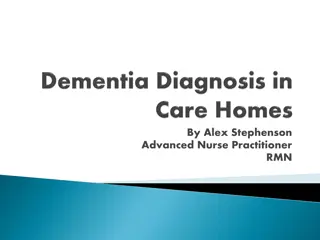Malabsorption Syndromes
The nursing management of pediatric patients with malabsorption syndromes, including identification of common gastrointestinal problems, implementation of the nursing process, and nutritional therapies.
Download Presentation
Please find below an Image/Link to download the presentation.
The content on the website is provided AS IS for your information and personal use only. It may not be sold, licensed, or shared on other websites without obtaining consent from the author. Download presentation by click this link. If you encounter any issues during the download, it is possible that the publisher has removed the file from their server.
- malabsorption syndromes
- pediatric nursing
- genetic disorders
- gastrointestinal dysfunction
- nursing process
- nutritional therapies
Presentation Transcript
Malabsorption Syndromes Nursing management of pediatric patients with Genetic disorders | The Child with Gastrointestinal Dysfunction Dr. Moustafa Ali
O B J E C T I V E S After mastering the contents of this lecture, you should be able to: 1. Identify the common problems affecting the gastrointestinal system during childhood 2. Provide nursing care to a child with malabsorption syndrome by implementing the nursing process 3. Identify nutritional therapies for the child with a malabsorption syndrome
Malabsorption Syndromes These include disorders with impaired digestion and or absorption. Classification is done according to anatomic and or biochemical defect it has: (continued)
Malabsorption Syndromes Four characteristics Seatoria (Fatty, Foul, Frothy bulky stools) General malnutrition Abdominal distention Secondary Vitamin deficiencies
Digestive defects Include diminished or absent enzymes such as: 1. Cystic fibrosis: Pancreatic enzyme is absent 2. Biliary liver disease: bile flow is affected (Artesia of the bile duct) 3. Lactase deficiency: Congenital or secondary Lactase intolerance
Absorptive defects Conditions in which the intestinal mucosal transport system is impaired. Primary defect (Celiac disease) or Secondary to inflammatory disease in the bowel leading to impaired absorption, because bowel mobility is accelerated such as Ulcerative Colitis Obstructive Disorders such as Hirschsprung's Disease can cause secondary malabsorption from Enterocolitis. Anatomic defects: extensive resection of the bowel or short bowel syndrome.
Celiac disease (CD) Gluten induced enteropathy, gluten sensitive enteropathy (GSE) Celiac sprue. It is secondary to cystic fibrosis to cause malabsorption in children (continued)
Incidence Incidence 1:4000 but it appears to be declining may be due to environmental factors. ++ in Europe and rare in America and is rarely reported in Asians or blacks Cause is unknown There is no inherited predisposition with an influence by environmental factors
Pathophysiology Intolerance of gluten a protein found in Wheat, Barley, Rye and Oats Gluten consists of: Glutenin Gliadin: Susceptible individuals are unable to digest gliadin fraction resulting in accumulation of a toxic substance that damage the mucosal cells leading to villi atrophy, and reducing the surface for absorption in the small intestine
Diagnosis C/M noticed at 3 6 months following introduction of gluten containing grains into diet Age usually 9 - 12 months villi of the intestine
Diagnosis C/M insidious and chronic they include: Impaired fat absorption: Steatorrhea and exceedingly foul smelling stools
Diagnosis Impaired absorption of nutrients leading to: Malnutrition Muscle wasting (legs and Buttocks) Anemia Anorexia Abdominal distention
Diagnosis Impaired absorption of nutrients leading to: Behavioral changes: Irritability Fretfulness Uncooperativeness Apathy
Diagnosis Celiac crisis (in very young infants): Present as acute, severe episodes of profuse watery diarrhea and vomiting
Diagnosis Celiac crisis (in very young infants): May be precipitated by: Infections (especially in the GI) Prolonged fluid and electrolyte depletion Emotional disturbances
Diagnosis Celiac crisis (in very young infants): First incidence may be failure to thrive and diarrhea Definitive diagnosis is by Jejunal biopsy that shows atrophy and changes in the small intestine The improvement after gluten free diet is also diagnostic which occur within a day or two
Diagnosis Celiac crisis (in very young infants): Change in personality, weight gain, increase in the appetite, and decrease in diarrhea and steatorrhea occur after several days or weeks Histological and or clinical relapse follow gluten reintroduction
Treatment NO Dietary management: Restricted Gluten diet Corn and rice are given instead Supplemental vitamins, Iron and Calories are given for severe malnutrition
Prognosis It is a chronic disease Most severe symptoms occur in early childhood and again in adult life Strict dietary avoidance can prevent symptoms and may minimize the risk of developing lymphoma one of the most serious complications
Nursing considerations To help the parents and the child to adhere to the prescribed diet To explain the disease process to them Advice parents to read all ingredients on labels to avoid hidden sources of Gluten as in Hydrolyzed vegetable protein e.g. Hotdogs, Pizza and Spaghetti, Instant soup these are not allowed.
Nursing considerations In severe cases Disaccharides digestion is impaired especially in relation to Lactose, so temporary Lactose free diet given, and (milk products) are restricted from the diet Diet should be high in calories and proteins with simple carbohydrate, fruits and vegetables and low fat. The rough vegetables and fruits are avoided until acute inflammation heals Any faulty in the diet will establish the previous signs and symptoms.
Evaluation 1. Identify the common problems affecting the gastrointestinal system during childhood? 2. Provide nursing care to a child with malabsorption syndrome by implementing the nursing process? 3. Identify nutritional therapies for the child with a malabsorption syndrome?
References Hockenberry, M. J., Wilson, D., (2015) Wong s Nursing Care of Infants and Children 10th Edition. Mosby, St Louis MO. Pillitteri, A.: Maternal And Child Health Nursing: care of the childbearing and childrearing family, 2010, 6th edition
Thankyou You can find me at: mustafa11ali@yahoo.com



